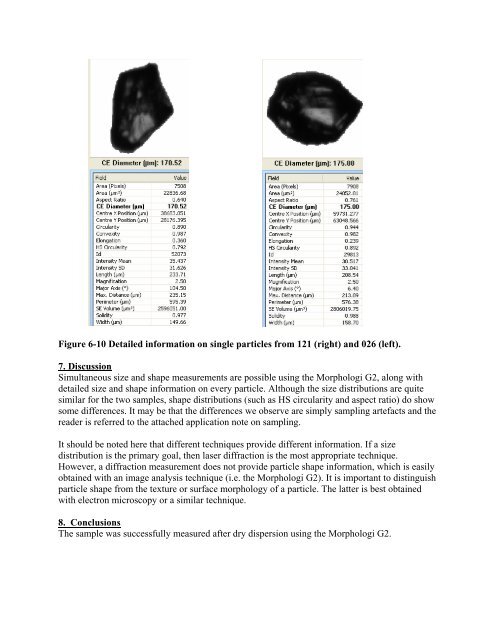Measurement of Particle Size and Shape Distribution For ... - Nasa
Measurement of Particle Size and Shape Distribution For ... - Nasa Measurement of Particle Size and Shape Distribution For ... - Nasa
Figure 6-8 Images of single particles from 121. Figure 6-9 Images of particles from 026. The instrument also provides detailed information about each particle analyzed as show below for both samples.
Figure 6-10 Detailed information on single particles from 121 (right) and 026 (left). 7. Discussion Simultaneous size and shape measurements are possible using the Morphologi G2, along with detailed size and shape information on every particle. Although the size distributions are quite similar for the two samples, shape distributions (such as HS circularity and aspect ratio) do show some differences. It may be that the differences we observe are simply sampling artefacts and the reader is referred to the attached application note on sampling. It should be noted here that different techniques provide different information. If a size distribution is the primary goal, then laser diffraction is the most appropriate technique. However, a diffraction measurement does not provide particle shape information, which is easily obtained with an image analysis technique (i.e. the Morphologi G2). It is important to distinguish particle shape from the texture or surface morphology of a particle. The latter is best obtained with electron microscopy or a similar technique. 8. Conclusions The sample was successfully measured after dry dispersion using the Morphologi G2.
- Page 1 and 2: SAP #: 10011301 Measurement of Part
- Page 3 and 4: Contents 1. Objectives 2. Backgroun
- Page 5 and 6: Table 6-1 Size and shape results fo
- Page 7 and 8: CE Diameter (µm) smoothed over 100
- Page 9: Aspect Ratio smoothed over 50 point
Figure 6-10 Detailed information on single particles from 121 (right) <strong>and</strong> 026 (left).<br />
7. Discussion<br />
Simultaneous size <strong>and</strong> shape measurements are possible using the Morphologi G2, along with<br />
detailed size <strong>and</strong> shape information on every particle. Although the size distributions are quite<br />
similar for the two samples, shape distributions (such as HS circularity <strong>and</strong> aspect ratio) do show<br />
some differences. It may be that the differences we observe are simply sampling artefacts <strong>and</strong> the<br />
reader is referred to the attached application note on sampling.<br />
It should be noted here that different techniques provide different information. If a size<br />
distribution is the primary goal, then laser diffraction is the most appropriate technique.<br />
However, a diffraction measurement does not provide particle shape information, which is easily<br />
obtained with an image analysis technique (i.e. the Morphologi G2). It is important to distinguish<br />
particle shape from the texture or surface morphology <strong>of</strong> a particle. The latter is best obtained<br />
with electron microscopy or a similar technique.<br />
8. Conclusions<br />
The sample was successfully measured after dry dispersion using the Morphologi G2.



